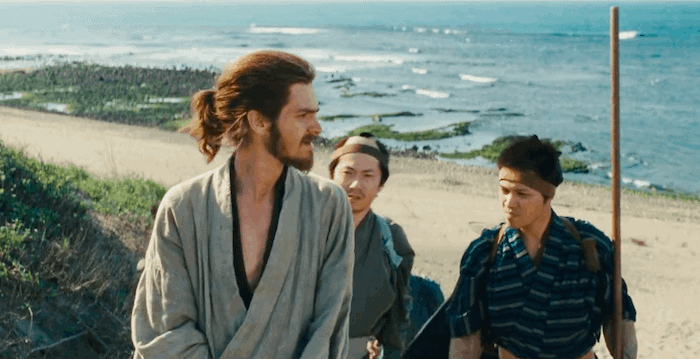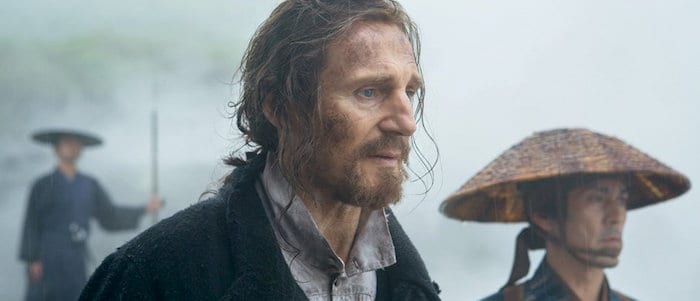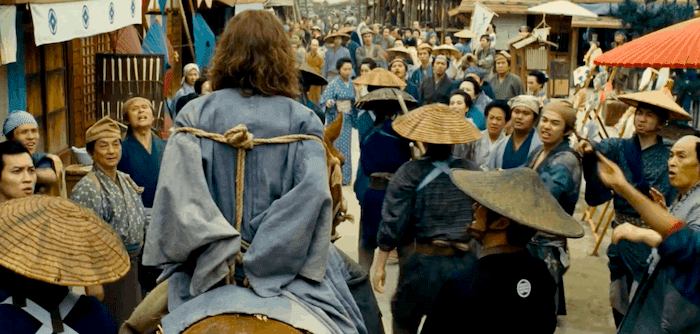You can take the boy out of the Church, but you can’t take the Church out of Marty Scorsese. Fearless and probing, director Scorsese seems unstoppable in his restless (tormented?) quest for redemption. There have been other paths through his personal journey that circles around the miracle of the Christian resurrection. Good Fellas. The Wolf of Wall Street. The Last Temptation of Christ. But Silence is the most intimate, even in its monumental scale. Almost shocking in its adherence to religious ritual, prayer, ecclesiastical devotion, Silence portrays as much as it narrates an historic moment of brutal religious persecution—of Portuguese Jesuit missionaries by the dominant political structure of Japan, to whose shores the priests have come to convert poor peasants to the One True Faith.
 Andrew Garfield as Father Rodrigues and Adam Driver as Fr. Garrpe play 17th century priests on a quest to find their mentor and teacher Father Ferreira (Liam Neeson), rumored to have renounced his faith (apostasy, in Catholic terms) and not heard from in years. Such a quest—for a lost man of God, by two young and untried ministers—takes a resourceful storyteller through rich emotional and scenic landscapes. And Silence is stuptifyingly beautiful. Imagine an Ingmar Bergman meditation on lost faith and inner psychology, set in the atmospheric texture of Japan’s lakes, shores, volcanic terrain, and design-intensive interiors. It is gorgeous, gorgeous enough to take the Oscar for Best Cinematography, to be sure. Yet the healing benediction the director so desires—like the elusive and silent God he seeks— remains just off-screen.
Andrew Garfield as Father Rodrigues and Adam Driver as Fr. Garrpe play 17th century priests on a quest to find their mentor and teacher Father Ferreira (Liam Neeson), rumored to have renounced his faith (apostasy, in Catholic terms) and not heard from in years. Such a quest—for a lost man of God, by two young and untried ministers—takes a resourceful storyteller through rich emotional and scenic landscapes. And Silence is stuptifyingly beautiful. Imagine an Ingmar Bergman meditation on lost faith and inner psychology, set in the atmospheric texture of Japan’s lakes, shores, volcanic terrain, and design-intensive interiors. It is gorgeous, gorgeous enough to take the Oscar for Best Cinematography, to be sure. Yet the healing benediction the director so desires—like the elusive and silent God he seeks— remains just off-screen.
[I’ll get back to my main commentary in a minute, but let me digress. Never has an audience been dragged through the spectacle of so much mud, so much rain, so many bad hair days, so many painfully skinny bodies, and such brutally thick accents as in Silence. So closely does Scorsese’s loveletter adhere to the faith he can’t quite abandon that you can practically walk the Stations of the Cross in the 2 hours + of the film. Frankly, I admire all of that, the willingness to set irony aside and devoutly detail the deep tissue message of Christian martyrdom, the charity extended to one’s enemies, the absolution granted even to serial liars and thieves. But can we talk about casting?
Scorsese insisted on casting fine Japanese actors in the appropriate roles. Alas, during much of the film these same actors speak their lines in English. Incomprehensible English. This was surely the time for subtitles Marty! The main protagonist, the priest upon whose skinny shoulders the tale hangs is played by puppy-dog visaged Andrew Garfield. He acts his guts out and is incredibly convincing as a priest pushed to the very gates of hell, but his face is so weak that the film caves in during his extended scenes of captivity and philosophical dialogue with Buddhist honchos. He is seriously unappealing. (See my review of Lion, where we would follow the compelling Dev Patel anywhere. I would follow the chinless Garfield nowhere. Perhaps this is simply a matter of taste, but I doubt it.)
 The most egregious casting woe is, in two words, Liam Neesom. As the apostate priest/mentor, finally discovered in an upscale domicile of Buddhist temple elite, Neeson looks as much like a Porteguese friar as do I, the product of Norwegian/Scottish-Irish ancestors. Give me a break. Plus his sorrow-ravaged face appears to be permanently dialed to “agony.”
The most egregious casting woe is, in two words, Liam Neesom. As the apostate priest/mentor, finally discovered in an upscale domicile of Buddhist temple elite, Neeson looks as much like a Porteguese friar as do I, the product of Norwegian/Scottish-Irish ancestors. Give me a break. Plus his sorrow-ravaged face appears to be permanently dialed to “agony.”
We, the audience, want to love everything that Martin Scorsese does. We endure beheadings, torture by water, by fire, by mud. We endure the sight of Adam Driver’s ribcase and Andrew Garfield’s chipmonk cheeks. But it’s hard to endure Liam Neeson’s massive Irish frame and face pretending to look Portuguese. Where was Antony Banderas when this film was cast? I know he can’t act but he sure can look authentically Portuguese.
Okay. Here’s my summary. Silence was as elegaic a film as it is possible to make. The music alone was transcendent. It was terrific to hear so much of the Catholic mass actually said in Latin (devotees of old school Catholicism will be thrilled), and I found my eyes deeply comforted by the impeccable design of Japanese interiors. The ocean never looked better. But I couldn’t recommend this film with any enthusiasm. Cinematographic geeks definitely will want to check it out. Everybody else, probably not. I would recommend streaming Scorsese’s actual religious masterpiece, The Last Temptation of Christ, and feasting on what sensual apostasy can look like when it’s done with religious fervor. And by Willem Dafoe.



I agree – the trailers showing Andrew Garfield made me decide to skip this. At least Liam Neeson is doing something besides the “Taken” series.